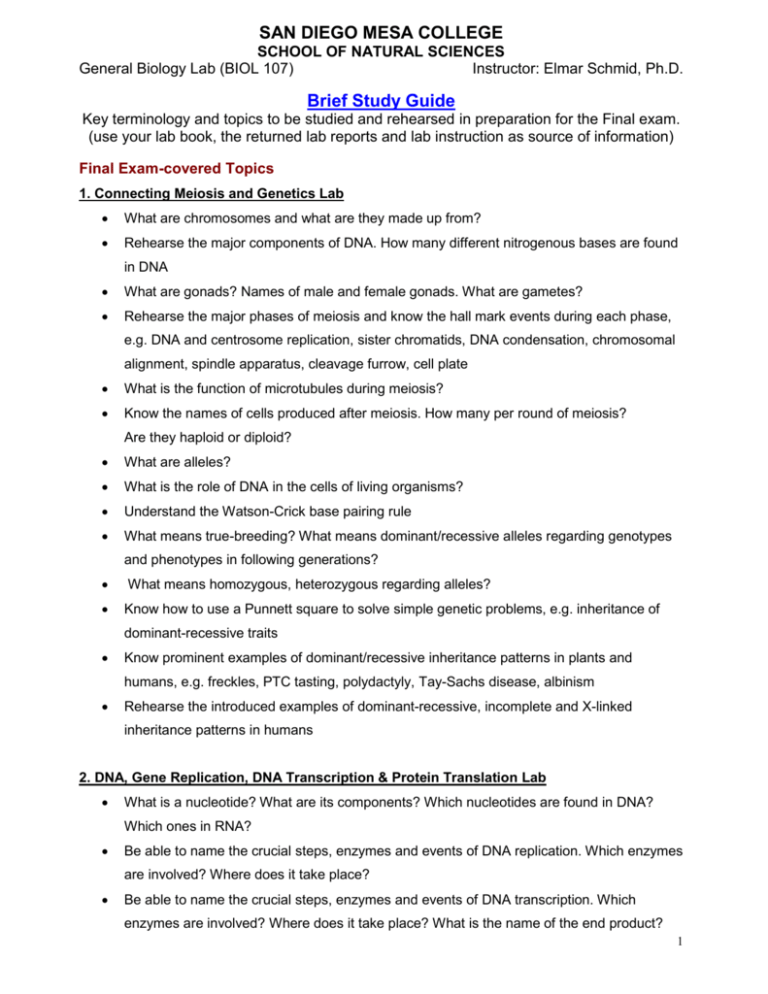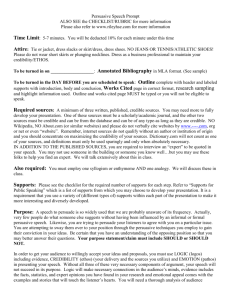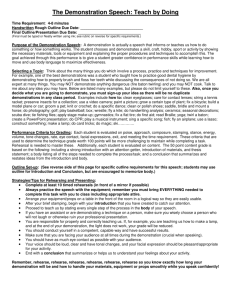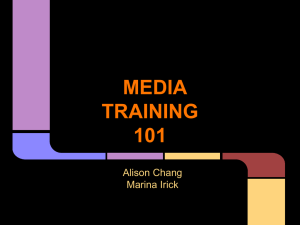Brief Study Guide Key terminology and topics to be studied and
advertisement

SAN DIEGO MESA COLLEGE SCHOOL OF NATURAL SCIENCES General Biology Lab (BIOL 107) Instructor: Elmar Schmid, Ph.D. Brief Study Guide Key terminology and topics to be studied and rehearsed in preparation for the Final exam. (use your lab book, the returned lab reports and lab instruction as source of information) Final Exam-covered Topics 1. Connecting Meiosis and Genetics Lab What are chromosomes and what are they made up from? Rehearse the major components of DNA. How many different nitrogenous bases are found in DNA What are gonads? Names of male and female gonads. What are gametes? Rehearse the major phases of meiosis and know the hall mark events during each phase, e.g. DNA and centrosome replication, sister chromatids, DNA condensation, chromosomal alignment, spindle apparatus, cleavage furrow, cell plate What is the function of microtubules during meiosis? Know the names of cells produced after meiosis. How many per round of meiosis? Are they haploid or diploid? What are alleles? What is the role of DNA in the cells of living organisms? Understand the Watson-Crick base pairing rule What means true-breeding? What means dominant/recessive alleles regarding genotypes and phenotypes in following generations? What means homozygous, heterozygous regarding alleles? Know how to use a Punnett square to solve simple genetic problems, e.g. inheritance of dominant-recessive traits Know prominent examples of dominant/recessive inheritance patterns in plants and humans, e.g. freckles, PTC tasting, polydactyly, Tay-Sachs disease, albinism Rehearse the introduced examples of dominant-recessive, incomplete and X-linked inheritance patterns in humans 2. DNA, Gene Replication, DNA Transcription & Protein Translation Lab What is a nucleotide? What are its components? Which nucleotides are found in DNA? Which ones in RNA? Be able to name the crucial steps, enzymes and events of DNA replication. Which enzymes are involved? Where does it take place? Be able to name the crucial steps, enzymes and events of DNA transcription. Which enzymes are involved? Where does it take place? What is the name of the end product? 1 SAN DIEGO MESA COLLEGE SCHOOL OF NATURAL SCIENCES General Biology Lab (BIOL 107) Instructor: Elmar Schmid, Ph.D. Know where protein translation takes place and which components are necessary. (hint: ribosome, rRNA, tRNA, mRNA) Rehearse the genetic code. Know that it is a triplet code and that 3 nucleotides code for one amino acid. Be able to read the code and to predict the amino acid sequence of a given mRNA strand sequence. 3. Natural Selection Lab Be able to define Natural Selection. Which factors/conditions associated with life forms favor successful adaptation to changed environments? What is selective pressure? Which selective pressure was applied/simulated in the lab during the bird experiment? Who introduced the concept of natural selection to explain evolution of life on planet earth? 4: Simple Animal Lab Rehearse the animal characteristics, especially the morula, blastula and gastrula stage of embryonic development in animals. Know the names of the three germ layers and their later function in the adult animal = ectoderm, mesoderm, endoderm. Rehearse the different 9 animal phyla and their basic anatomical characteristics, including body symmetry, type of digestive system, nervous system, body cavities, type of skeleton. What is the difference between a “true animal” and a “false animal” (= parazoa)? The cell types of a typical sponge. What is meant in biology with an incomplete digestive system? Who was Dugesia? Know the basic characteristics of flatworms. Know the basic characteristics of roundworms. What is a coelom and in which animal phyla can you find one? What is the advantage animals gained in evolving a third body cavity or coelom? Know the basic characteristics of an earthworm. What type of locomotion is used? Know the basic characteristics or arthropods. What is an exoskeleton made up from? What is it used for? What is metamorphosis? Which role does it play and in which animal phyla? 2 SAN DIEGO MESA COLLEGE SCHOOL OF NATURAL SCIENCES General Biology Lab (BIOL 107) Instructor: Elmar Schmid, Ph.D. 5. White Rat Dissection Lab Rehearse the names and basic physiological functions of the key organs in the thoracic and abdominopelvic cavity, including liver, pancreas, thymus, spleen, thyroid gland, adrenal gland. Know the names and functions of the hormones of the pancreas What is the role of the diaphragm? Where is it located? Know the names of the individual parts of the mammalian excretory system Know the function, chambers and major vessels of the human heart Know the major physiological functions of the liver and its location in the visceral cavity Know the difference between dorsal, lateral and ventral. Know the names of the different sections of the small and large intestinal tract and know which part(s) is/are responsible for food resorption. Rehearse the names and physiological function(s) of the external and internal structures of the human male and female reproductive system, incl. testis, seminal vesicle, prostate gland, epididymis, vas deferens, ovary, fallopian tube, vagina, uterus, fimbriae Know the names of important hormones regulating sperm production and the menstrual cycle. Rehearse the names and location of the major anatomical features of the human heart, including atria, ventricles, A/V valves, pulmonary arteries and veins, aorta, vena cava Know which sections of the heart carry oxygen-poor, which ones oxygen-rich blood 6. “Origin of Species” Video Rehearse the key concepts of the evolutionary theory including genetic variation (random shuffle), over production, natural selection Who was accused in the Scope’s Monkey trial? For what? What is speciation? Rehearse: BMS Beagle journey, Galapagos islands, finches, common ancestor, common descent theory. Know which factors/processes contribute to variation in the genetic material of living beings. Hint: crossing over/recombination/mutations/viruses/transposons Know the names of important evolutionary biologists as mentioned in the video What is social Darwinism? What do evolutionary biologists mean by “reproductive barrier”? What can it lead to over time? 3 SAN DIEGO MESA COLLEGE SCHOOL OF NATURAL SCIENCES General Biology Lab (BIOL 107) Instructor: Elmar Schmid, Ph.D. Rehearse the concept of the Homo-Chimp split theory. When do scientists think that it has happened and where? 7. Plants Lab Know the shared features of green algae and green plants, e.g. cell wall, nucleus, zygote location, storage sugar Know the crucial stages of the plant life cycles of mosses, ferns, conifers, and flowering plants and important plant structures, e.g. gametophyte, sporophyte, archegonium, antheridium, zygote, spores, microsporangia, macrosporangia, gametes Know and identify the unique gametophyte and sporophyte stages for these 4 major groups of plants, components of a spore and a seed Know which major plant types are tracheophytes, i.e. plants which express water/nutrient conducting vessels. What is a Prothallium? What is its function in ferns? Know the names of the reproductive structures of a typical flowering plant. What is the role of the ovule, anthers, ovary wall, stamen of a flowering plant? Rehearse the plant structures which are important adaptations to dry land conditions Know which of the four plant groups evolved first … and last on planet Earth Don’t forget to bring a Scantron card and a soft pencil for the Final exam 4 5







